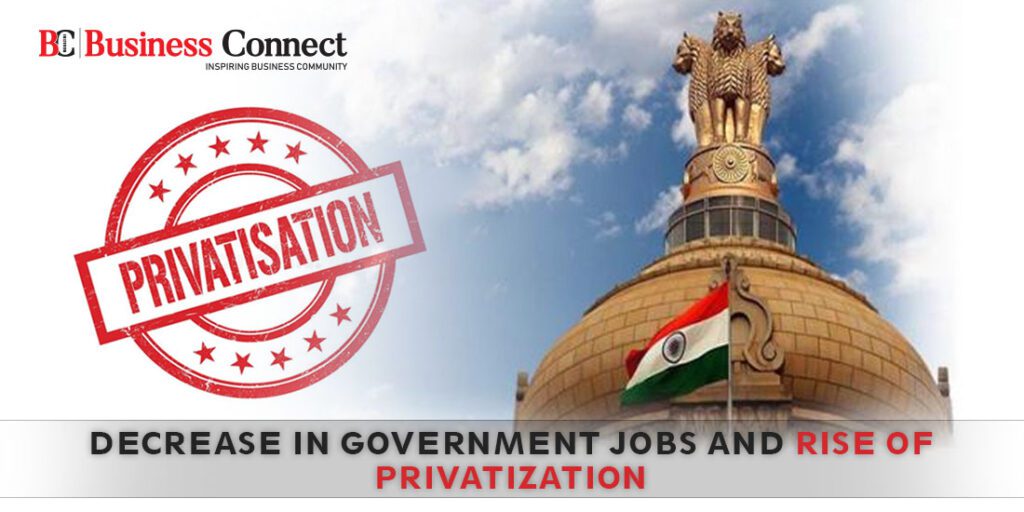Decrease in Government Jobs and Rise of Privatization
Government hiring has fallen on a number of levels throughout the years. The trend is projected to continue as departments at all levels of government, including the centre government and state governments, reduce permanent posts in favour of contract work. Government employment hiring has dropped to its lowest level in at least three fiscal years, 2020-21. According to payroll data from the National Pension System, the federal government recruited 27% fewer individuals, while states hired 21% less people (NPS).
In FY20, the central government hired about 119,000 permanent employees, but that number decreased to 87,423 in FY21. In FY21, states recruited 389,052 individuals, down roughly 107,000 from the previous year. On the other hand, private sector employment has increased dramatically over the years, boosting India’s GDP significantly. The private sector is a vital player in creating jobs, supplying cash, increasing competitiveness, and promoting innovation, all of which are critical components of growth.
In the last few years, the private sector has produced a lot of jobs in India’s tier-1 and tier-2 cities, which has piqued people’s interest in it. Employees at companies like Infosys and TCS have jobs, job stability, and a variety of benefits.
Decline in Government Jobs
It has been noticed that the Union Public Service Commission has declined in the number of job vacancies. The Commission announced 1364 vacancies in 2014 which were reduced to 1164 in 2015. They were further reduced in subsequent years. Only 1209 were announced in 2016, 1058 in 2017 and then only 812 were declared in 2018. This drop in posts advertised stands at 47%. Such a drop is coming when the country struggles with the shortage of IAS and IPS officers.
In the same manner, the Staff Selection Commission (SSC) also showed the same pattern. There were 20,000 vacancies posted in 2013 by SSC which came down to 12,000 in 2018 and now they are about 8000-9000 only. Banking sector has also been advertising fewer jobs’ vacancies for some years due to merging of many banks Moreover, most exams have been marred by paper leaks, rescheduling the dates again and again and unnecessary delay in result declaration. The government is choosing to fill the vacancies on an ad hoc basis in many organisations.
The Reasons Behind It
Academics are of the opinion that the reduction in the number of vacancies in the government sector is the result of privatisation, digitisation and automation. The liberalisation that happened in 1991 has shifted to the next level recently. Several policies implemented lately have caused a considerable reduction in the number of vacancies required in the government sector.
The work earlier done by men is being done by machines. For example, since GST implementation, the tax collection process has been automated. Resultantly, a few officials are needed to work for taxation. One of the factors of this downsizing of the public sector jobs is the inability of the government to create more jobs, ambiguous administrative process and lack of sincerity in conducting the exams.
Future of Youth
Addressing the concern of the people the government has assured that privatisation of central public sector enterprises will not cause job losses and all the facilities are provided. Minister of State for Finance Anurag Singh Thakur further said the disinvestment will bring investment, technology infusion, job opportunities. This move will create more job opportunities instead of reducing them. Government is inviting MNCs by offering them PLI which will give a major boost to private sector employment. At the same time, the government is upgrading the quality of roads and highways, airports, industrial parks and emphasizing on developing the skills of the people to make India more resourceful.
In his address PM Narender Modi has also said that it is the responsibility of the government to give the full support to the enterprises of the country, to the businesses, but it is not possible and feasible for the government to run the enterprises in today’s time and added that government has no business to be in business. Defining the path of the government he said that the government’s focus must be on the projects and schemes pertaining to the welfare and development of the people. Government’s power, capacity and resources are meant for welfare work and if a government starts doing business it does damage rather than construction.
Conclusion
With the onset of the fourth Industrial Revolution, India is on the verge of a technological transition that has the potential to overhaul the country’s manufacturing and industrial output fortunes. The private sector has the ability to harness and exploit technology to help the country develop. In the future years, it is expected that the government would continue to reduce public sector employment in order to promote the private sector and increase its part of the Indian economy.
Must Read:-
- Top 10 Young Entrepreneurs in India 2022
- Upcoming Indian Web Series for 2022-23
- Top 10 Hospitals in India 2022
- Top 10 richest player of the world 2021
- Top 10 highest-paid Indian Athletes 2021
- Top 10 highest paid CEO in the World
- Top 10 richest person of India
- Top 10 Highest Paid CEOs of India
- List Of Most Followed Facebook Pages in 2022
- The Success Story of Jeff Bezos
- Success Story Of Elon Musk
- Top 10 Business Magazine In India
- Top 10 Business Newspaper In India
- Top 10 richest billionaires in the world 2021
- Upcoming English Web Series in 2021
- Top 10 Tourist Places in India, places to visit after lockdown



